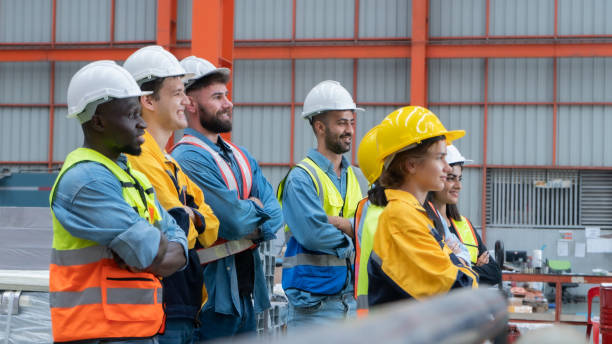Construction work is risky. Heavy tools, unstable heights and loud machines all add up. One wrong move can mean injury or worse. That’s why safety skills aren’t just helpful—they’re a must.
This blog breaks down the essential skills every worker needs to stay safe on site. No fluff. Just practical stuff that can make a difference.
Core Safety Skills Every Worker Must Have
A few key skills show up on every site. Doesn’t matter if it’s a small refurb or a high-rise build. These are the basics.
1. Hazard Recognition
Hazards don’t always shout. Some hide in plain sight. Slippery floors, loose wires or badly stacked materials. Workers need sharp eyes and quick thinking. If something looks wrong, it probably is.
2. Use of PPE (Personal Protective Equipment)
Hard hats. Gloves. Safety boots. PPE saves lives. But wearing it isn’t enough. Workers should know what gear to pick and how to wear it right. A poorly fitted helmet is as bad as no helmet at all.
3. Manual Handling Techniques
Back injuries are common. Often permanent. Lifting the wrong way can do serious damage. Workers must know the basics—bend knees, keep the load close, don’t twist. Every job, every time.
4. Working at Height Awareness
Falls are deadly. Even a short drop can break bones. Scaffolds, ladders and cherry pickers come with rules. Knowing them isn’t optional. A proper harness inspection course can teach how to use a harness correctly and spot signs of damage before it’s too late.
5. Fire Safety Basics
It’s not just about fires starting. It’s about how to react. Where’s the nearest extinguisher? Which exit is quickest? Smoke spreads fast. So must the response.
6. Electrical Safety Knowledge
Electric shocks can kill on the spot. Even small tools carry risk if wires are damaged or plugs are dodgy. Workers need to know how to check gear and avoid live contact. Lockout procedures aren’t just for electricians.
7. Safe Use of Tools and Machinery
A grinder can cut steel. It can also slice skin in seconds. Training matters. So does doing daily checks. No one should use a tool they don’t understand or a machine that sounds off.
Communication and Team Coordination
Even with the best skills, no one stays safe alone. Construction sites are busy. Noise, movement, and constant change mean workers must talk, point, and double-check.
Understanding Site Signals and Signs
Signs are everywhere—on walls, fences, and even painted on the floor. They give quick warnings. High voltage. Trip hazard. No entry. Knowing what they mean can save time and lives.
Reporting Hazards and Near Misses
If something nearly went wrong, it should be logged. Not ignored. Near misses are early warnings. Reporting them means fewer real accidents down the line.
Coordinating With Others in Confined or Shared Spaces
Tight corners. Shared scaffolds. One mistake affects everyone. Workers must know who’s around, what tools are in use, and when it’s safe to move or lift. Silence is a risk.
Site-Specific Induction and Procedures
Every site is different. Layout, risks, rules. What works on one site might not work on another. That’s why inductions matter.
Workers shouldn’t skip them or treat them like a tick-box exercise. They cover exits, hazards, permits and site contacts. Even where the first aid kit is kept. New hazards can pop up anytime, so a quick daily briefing helps too.
No one should step onto a site without knowing the basics. It’s not just for legal cover. It keeps people alive.
Stay Sharp: Mental Readiness on Site
Being alert isn’t just about avoiding mistakes. It’s about spotting them before they happen.
Fatigue and Distraction
Tired workers miss things. Distractions—phones, loud noises, even personal issues—get in the way. Construction isn’t forgiving. A second of inattention can lead to a fall, a cut or worse.
Workers should know when to take a break. Supervisors should check in too. Mental fatigue shows in body language. Slower responses. Missed steps. That’s when it’s time to stop and reset.
Confidence vs Complacency
Experience helps, but overconfidence is dangerous. Just because someone has done a job 100 times doesn’t mean it’s safe the 101st. Safety checks aren’t optional. They’re daily.
When Things Go Wrong
No matter how careful workers are, accidents happen. The difference is in the response.
Understanding Emergency Plans
Who to call. Where to go. What to do. Every worker needs to know the answers. Not just once during induction. These need repeating often.
Assembly points, emergency contacts, how to raise the alarm—these save time when seconds count.
First Aid Basics
Workers don’t need to be medics. But they should know how to stop bleeding, clear airways or keep someone still until help arrives. Basic first aid stops small injuries becoming major ones. Some jobs require a certified first aider on site at all times. Everyone else should still know the basics.
Rules, Law and Knowing Your Rights
Safety isn’t just about skills. It’s also about knowing the law.
Health and Safety at Work Act 1974
This law makes it clear: employers must keep sites safe. But workers have duties too. Follow procedures. Use equipment properly. Report risks. Knowing this helps workers speak up when something’s not right.
Role of the HSE
The Health and Safety Executive doesn’t just investigate accidents. It sets the rules, runs inspections and issues notices when standards slip.
Courses like underground services training often explain these legal duties. They show how safety connects to real law. Not just theory.
Building Safer Sites, One Skill at a Time
Construction will always carry risk. But risk doesn’t have to mean danger. When workers know what to look for, how to act and when to speak up, accidents drop.
Skills matter more than gear. More than signs. They come from training, habits and paying attention every single day.
It’s not about being perfect. It’s about being ready. Safety isn’t luck. It’s a skill set. And it starts with knowing what could go wrong—and doing something before it does.






